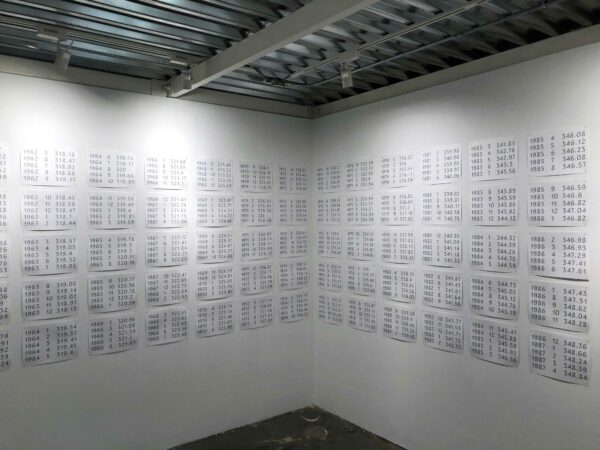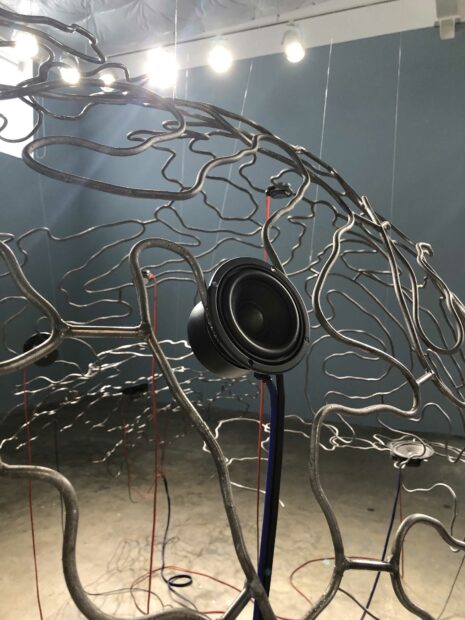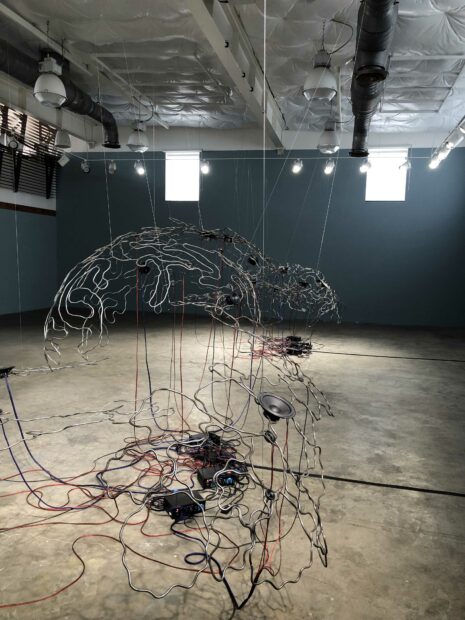As Galveston is currently in its off season, Miguel Sbastida’s installation, Voice of Coral, on view at the Galveston Artist Residency (GAR), interestingly mimicks the quietness of the city. When I stepped out of the car into the island community, I felt like I stepped back in time. I couldn’t place the architectural style, but understood it to be a mishmash of New Orleans, nautical colors, and classic industrial, all with wear and tear from too many hurricanes. I cannot stress how eerily quiet the city was at that moment, only seagulls gawking overhead and a lone car driving by every few minutes. Then, unexpectedly, industry slapped me in the face, and I spotted a cruise ship so large, and only two or three blocks away, that I at first thought it was a building. As I stood there confused while observing my surroundings, I was unknowingly about to enter a show largely about the human impact on the planet over time.
Inside the GAR Gallery, Sbastida has painted the walls a medium blue-gray color, referencing both water and sky. Two wiry, bulbous sculptures appear to rest on the floor, but are actually suspended from the ceiling, giving them a sense of lightness as they “float” in the room.
I’m having difficulty describing the surfaces of the sculptures. They are composed of a series of open shapes that simultaneously reference brain mapping, water topography, outlines, and line contouring. The shapes are welded together along their edges and occasionally accented by speakers ranging in size. The speakers act as points of emphasis along the surface due to their contrast in shape, position, and color, but also their function. You’re never sure which one is emitting sound (a pop) or when the next sound (a gurgle) will come; this adds another form of movement, activating the ear with noises that are both close and far away. Wires hang within the sculpture, from the speakers, connecting to a series of mixers, iPod Nanos, and iPod Shuffles on the floor. At first glance the hanging wires remind me of the brain and its many wrinkles, veins, and arteries. But it breaks away from that fairly quickly due to the soft notes emanating throughout the space. Overall, the composition of the sculpture is pretty solid. I believe whatever it is telling me to be true, but more on that later.
The smaller gallery’s walls are lined with sheets depicting numbers in a series of columns and rows. While the data is clearly categorized, the viewer has to decipher the categories for themselves. Quickly, you recognize the year and month in the first two columns, but unless you’re already informed about the issues surrounding coral and studies of oceanic restoration, the viewer may be a little lost. It was at this moment that I decide to consult the show’s didactics.
It reads, “Voice of Coral is the largest chapter in an ongoing research project connected to the postnatural ecologies of coral reefs, and the sophisticated technologies being implemented at oceanic respiration sites, in an effort to accelerate the coral’s adaptation to the changing climate. The exhibition looks closely at the technique of acoustic enrichment, through a series of sculptural sound-based works that invite the viewer to experience the language of coral creatures and the fading voice of a soundscape predicted to disappear within the next century.”
It goes on to say that the data in the smaller gallery is an ongoing record of the rising CO2 levels that endanger the coral. Somehow, someway, I wanted the artwork to speak even more to the “acoustic enrichment” referenced in the document, though I didn’t want the actual paper itself to tell me this, and it was an unfair situation to ask for as a viewer. I’m glad I caught myself in this moment. This is the tricky part about artwork that all artists grapple with, myself included: How much do you give the viewer? How much do you hold back? How literal does this object need to be? How much do you educate?
The answers to these questions can change a work completely as the creator oscillates between where to place the emphasis, like what is being explored (i.e. sheets of data), or by creating a form that embodies a thing in the world (i.e. coral reef). This is why we are quick to ask an artist what something “means.” Partly because we don’t want to be wrong, so we hope that our conclusions or assumptions are correct, and partly because we live in the Information Age. All to say, me wanting more from the sculpture is the embodiment of “I want the answer and I want it now!,” though it’s not the artist’s job to lead us through everything.
I left the space feeling ambivalent, or so I thought. But days later I was still thinking about the show. I kept pondering the quietness of it all, our impact as humans on the world around us as we take, take, take, take from each other and the planet. And when I sat down at my desk to write this review, I googled coral reefs. I watched videos on how we are changing (and destroying) ecosystems along the seafloor for oil, minerals, and food. I was reminded that I took a geology class in college in which we spent several classes toward the end of the semester looking at what was currently happening to the planet (temperature rising, water levels, glacier melting, etc.).
What I thought was a potential weakness of the show is actually its strength. The thing that I recognized as too quiet or in need of an extra layer of something was actually me, the viewer. The work felt incomplete because I needed to complete the circle and find the information. And a few days before Christmas that information led me down a rabbit hole about coral reefs, rising CO2 levels, and whether or not what I saw in the distance was indeed a cruise ship. I did exactly what Sbastida wanted me to do, which was to research and learn a little sumthin’ sumthin’. If you’re in the area and have the time, check out the show. Voice of Coral invites you to investigate what you question and what you don’t know. After all, when you stand still for a moment and surrender to the quiet, you may learn a thing or two.
Miguel Sbastida: Voice of Coral is on view at the Galveston Artist Residency through February 3, 2024. The show is curated by Regine Basha.







